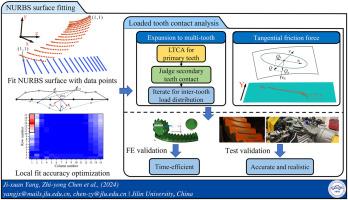Multi-tooth contact analysis of rough-flank hypoid gears based on non-uniform rational B-splines
IF 4.5
1区 工程技术
Q1 ENGINEERING, MECHANICAL
引用次数: 0
Abstract
In this study, a tooth flank modelling and contact analysis method for hypoid bevel gears is introduced using the non-uniform rational B-splines (NURBS) surface-fitting technique. Based on the effect of weighting factor variations on NURBS geometry, the local tooth-fitting accuracy is optimised while maintaining acceptable computational complexity. The simulations of meshing characteristic and flank micro-modification is conducted. The computational model for the loaded tooth contact analysis (LTCA) of a gear pair incorporates tangential friction at the contact point, and the influence of the friction one simulation results is thoroughly examined. Additionally, an iterative method is employed to extend the single-tooth LTCA to multi-tooth scenarios, which enables the calculation of tooth load distribution at a lower computational cost. The transmission error, meshing stiffness, and contact area obtained using the proposed rough-flank LTCA (R-LTCA) model agree better with experimental measurements than the results of finite-element simulation. The findings indicate that proposed R-LTCA method outperforms the finite-element method in terms of simulation accuracy and computation cost.

基于非均匀有理b样条的粗面准双曲面齿轮多齿接触分析
介绍了一种基于非均匀有理b样条曲面拟合技术的准双曲面锥齿轮齿面建模与接触分析方法。基于权重因子变化对NURBS几何形状的影响,在保持可接受的计算复杂度的同时,优化了局部齿形拟合精度。对其啮合特性和翼面微修容进行了仿真。建立了考虑接触点切向摩擦的齿轮副加载齿接触分析(LTCA)计算模型,并对摩擦对仿真结果的影响进行了深入研究。此外,采用迭代方法将单齿LTCA扩展到多齿场景,以较低的计算成本计算齿的载荷分布。采用所提出的粗面LTCA (R-LTCA)模型计算得到的传动误差、啮合刚度和接触面积与实验结果的吻合程度优于有限元仿真结果。结果表明,所提出的R-LTCA方法在模拟精度和计算成本方面优于有限元方法。
本文章由计算机程序翻译,如有差异,请以英文原文为准。
求助全文
约1分钟内获得全文
求助全文
来源期刊

Mechanism and Machine Theory
工程技术-工程:机械
CiteScore
9.90
自引率
23.10%
发文量
450
审稿时长
20 days
期刊介绍:
Mechanism and Machine Theory provides a medium of communication between engineers and scientists engaged in research and development within the fields of knowledge embraced by IFToMM, the International Federation for the Promotion of Mechanism and Machine Science, therefore affiliated with IFToMM as its official research journal.
The main topics are:
Design Theory and Methodology;
Haptics and Human-Machine-Interfaces;
Robotics, Mechatronics and Micro-Machines;
Mechanisms, Mechanical Transmissions and Machines;
Kinematics, Dynamics, and Control of Mechanical Systems;
Applications to Bioengineering and Molecular Chemistry
 求助内容:
求助内容: 应助结果提醒方式:
应助结果提醒方式:


